Background:
In today’s life for both women and men cosmetics plays an important role to beautifying and altering the appearance of skin. The use of natural ingredients to remain healthy and of good appearance, the skin surface requires frequent cleansing to remove oil, sebum and other secretions, dead cells, crusts and applied make-ups. Aim: This study aims on the formulating an herbal Face Scrub using natural ingredients incorporated into gel, For the purpose of enhancing skin beauty, several skin conditions are developed, such as skin protection, sunscreen, anti-acne, and anti-wrinkle products.
Material and Method
The aim of study is to formulate and evaluate a face scrub with incorporation of the Tamarind an active ingredient. For the purpose of enhancing skin beauty, several skin conditions are developed, such as skin protection, sunscreen, anti-acne, and anti-wrinkle products. In this preparation, Roasted gram peel are used to exfoliating activity. Other natural ingredients are tamarind powder and multani mitti used to remove grene, dust particles and acne. Esthetic ingredients used in this formulation include neutralizer, moisturizer and surfactants. Among this ingredients, gelling agent and preservative was used.
Result:
The herbal scrub was prepared and evaluated. The herbal facial scrub formulated in the laboratory was found to be compared with various parameters such as appearance, pH, and spreadability, wash ability, irritability and found to be satisfied with all required characterization.
Conclusion
The aim of formulating an Herbal face scrub was found to successful with good results. The face scrub showed a good spreadability. The formulation showed a good peel off property on our skin without causing skin irritation or edema
Herbal Face Scrub, Tamarind, Honey, Skin, Roasted Gram peel etc
Cosmetics Throughout History
The origin and evolution of cosmetics, from ancient times to the modern era.
Ancient Origins of Cosmetics
The term "cosmetics" traces its roots to the Greek word "kosmeticos," meaning adornment. Since ancient tribal days, humans have adorned themselves for beautification, with both men and women using various materials.
Evolution of Cosmetics
Over time, cosmetics expanded beyond adornment to include items like high-heeled shoes and artificial dentures. The acceptance and role of cosmetics in daily life increased significantly post-World War II, as they were recognized for their psychological and skincare benefits.
Modern Understanding of Cosmetics
Cosmetics are now considered essential commodities, not merely for adornment but also for skincare and psychological well-being. The skin, particularly the face, serves as an indicator of an individual's health.
Herbal Cosmetics and Cosmeceuticals
Herbal cosmetics utilize natural ingredients with cosmetic benefits, gaining popularity for their gentle and non-toxic properties. Cosmeceuticals, introduced in the 1990s, combine cosmetic and pharmaceutical properties, often using plant-based active ingredients for therapeutic benefits.
Medicinal Plants and Extraction Techniques
Medicinal plants have been used historically for various ailments and are now recognized as important sources of drugs. Extraction methods, including distillation, maceration, and solvent extraction, are used to obtain active components from plants for medicinal purposes.
Facial Scrubs and Exfoliation
Facial scrubs use mechanical or chemical means to exfoliate the skin, removing dead cells and promoting cell turnover. Herbal facial scrubs offer benefits such as reducing age-related changes and environmental damage.
Benefits of Scrubbing Your Skin
Scrubbing cleanses the skin, removes dead cells, and improves skin texture, promoting a clear, smooth, and glowing complexion. It can also help in the removal of dark patches, acne scars, and prevention of ingrown hair. At the end, Cosmetics have a rich history rooted in human desire for adornment and skincare. From ancient practices to modern formulations, cosmetics continue to play a vital role in personal grooming and well-being.
MATERIAL
Plant Material
Roasted gram Peel Powder, Tamarind Powder, Multani Mitti, Aloe vera, Saffron strand, Neem powder, Turmeric powder, Tulsi powder was taken as plant material in this formulation. Aloe-vera was collected from the Botanical Garden, Lucknow Model College of Pharmacy, Lucknow. Roasted gram Peel Powder, Tamarind Powder, Multani Mitti, Aloe vera, Saffron strand, Neem powder, Turmeric powder, Tulsi powder was purchased from the local market of Dubagga, Lucknow.
- Aloe-Vera
Synonym-
Aloe vera, burn plant
Biological source –
Dried latex of leaves of it also known as cape aloe belong to the
Family-liliaceae
Description –
Colour- clear to slightly yellow / translucent gold Odour-similar like rotten garlic or onion.
Taste- Bitter
Chemical constituents - aloe emodin.
Uses - heals burns and clears acne.
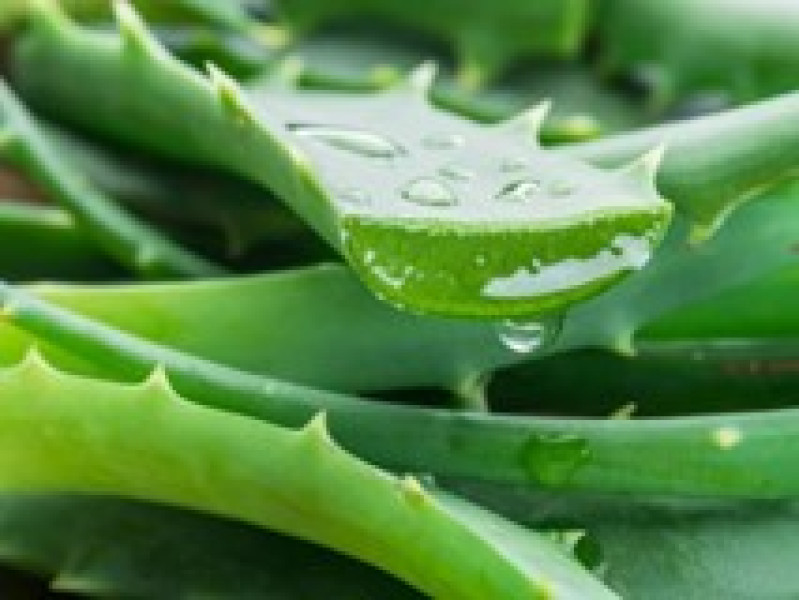
Fig 1: Aloe-Vera
- Honey
Synonym – Shahad
Biological source –
It consists of saccharine liquid prepared from the nectar of the flowers by Honeybee Apis mellifica belonging to family Apadae.
Description –
Colour- Yellow brown coloured liquid,
Odour – Sweet, Taste – Sweet.
Chief chemical constituents - Dextrose and laevulose (70-80%) Dextrin (0.06-1.25%) Proteins
Uses - Good for wrinkles and aging Prevent acne Remove dirt from pores.
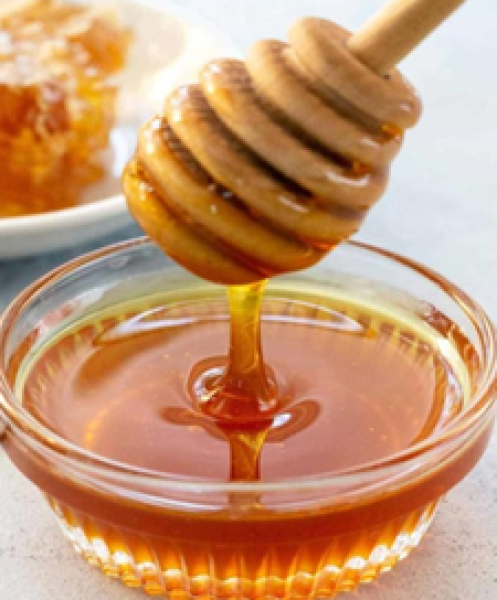
Fig 2: Honey
- Turmeric Powder
Synonym –
Curcuma longa
Biological source –
It consists of dried rhizomes of Curcuma longa belonging to family Zingiberaceae.
Description –
Colour - Yellow,
Odour – Aromatic,
Taste – Bitter
Chief chemical constituents - Curcumin, Curcuminoids
Uses –
Reduce acne, Glowing skin and Lightens skin. Turmeric has the potential to reduce swelling (inflammation) and irritation. Inflammation and irritation can aggravate other skin conditions, so using turmeric as a regular face mask can help.
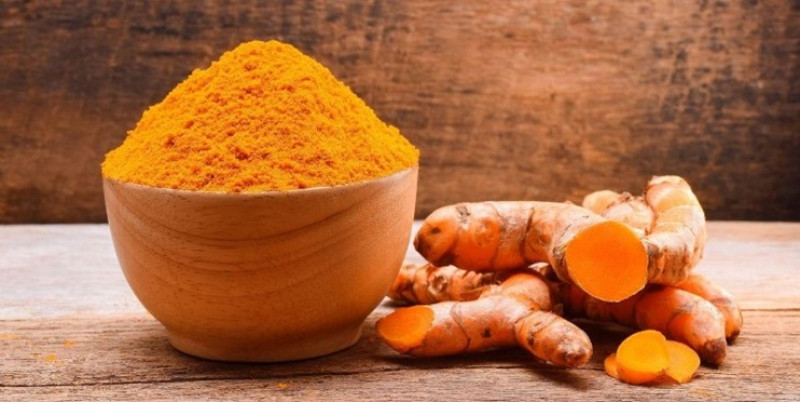
- Tulsi Leaves Powder
Synonym –
Tulsi
Biological source –
It consists of dried leaves of Ocimum sanctum L belonging to family Lamiaceae.
Description –
Colour- green , Odour-aromatic
Taste - Pungent
Chief Chemical constituents - oleanolic acid, ursolic acid, rosmarinic acid
Uses –
Prevents acne and pimples, Improve skin texture, Cleanser
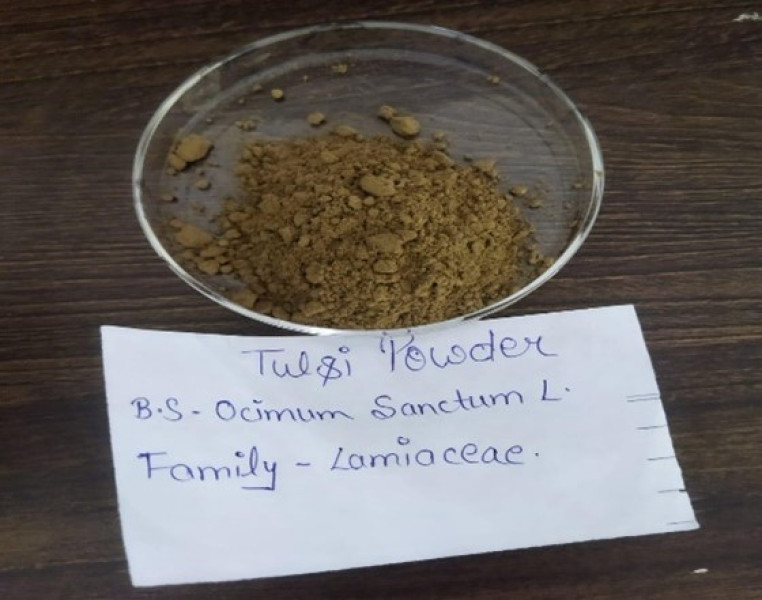
Fig 4: Tulsi Leaves Powder
- Saffron
Biological source:
It is the dried stigma and style tops of Crocus sativus Linn., belonging to family Iridaceae.
Description:
Colour- yellow-orange, Odour-aromatic
Taste: Bitter
Chief Chemical constituents :
carotenoids (crocetin, crocin, ?-carotene, lycopene and zeaxanthin), monoterpene aldehydes (picrocrocin and safranal), monoterpenoids, and isopherones.
Uses –
Protect the skin from harmful UV rays.
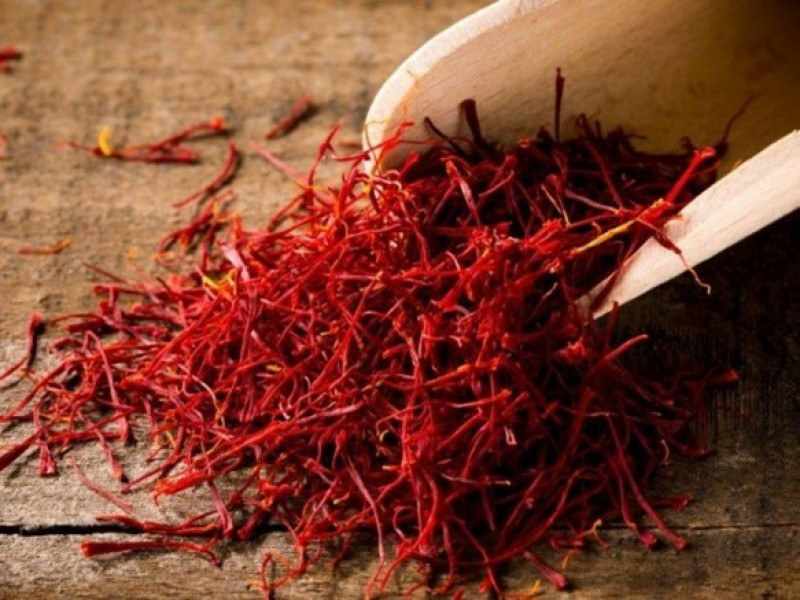
Fig 5: Saffron Stand
- Sandelwood Powder
Biological source –
Its oil is obtained by distillation of sandalwood, Santalum album Linn., belonging to family Santalaceae.
Description –
Colour- soft neutral with subtle reddish-brown undertones,
Odour- rich creamy
Taste- creamy, nutty taste similar to a macadamia, hazelnut, or almond.
Chief Chemical constituents - Sandalwood oil contains more than 90% sesquiterpenic alcohols of which 50–60% is the tricyclic ?-santalol.
Uses - Antiseptic and preservative
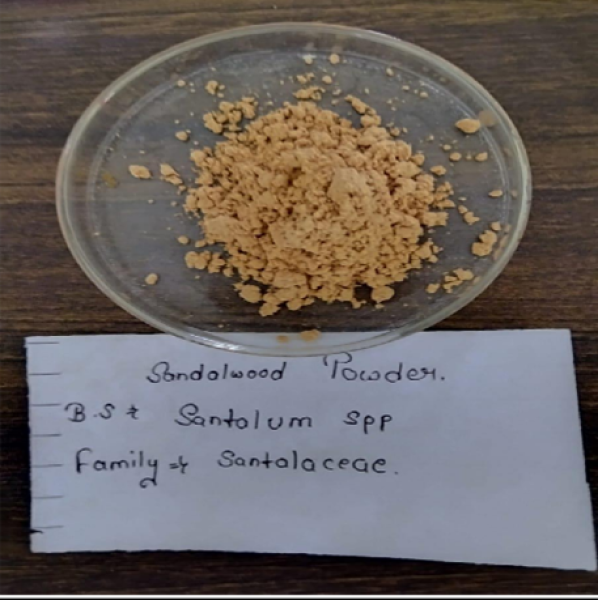
Fig.6: Sandalwood
- Tamarind Powder
Synonym –
Indian date, sour pulp, savanna date, and tamarindo.
Biological source –
Its oil is obtained by distillation of sandalwood, Santalum album Linn., belonging to family Santalaceae.
Description –
Colour- soft neutral with subtle reddish-brown undertones,
Odour- rich creamy
Taste- creamy, nutty taste similar to a macadamia, hazelnut, or almond.
Chief Chemical constituents –
Sandalwood oil contains more than 90% sesquiterpenic alcohols of which 50–60% is the tricyclic ?-santalol.
Uses –
Antiseptic and preservative
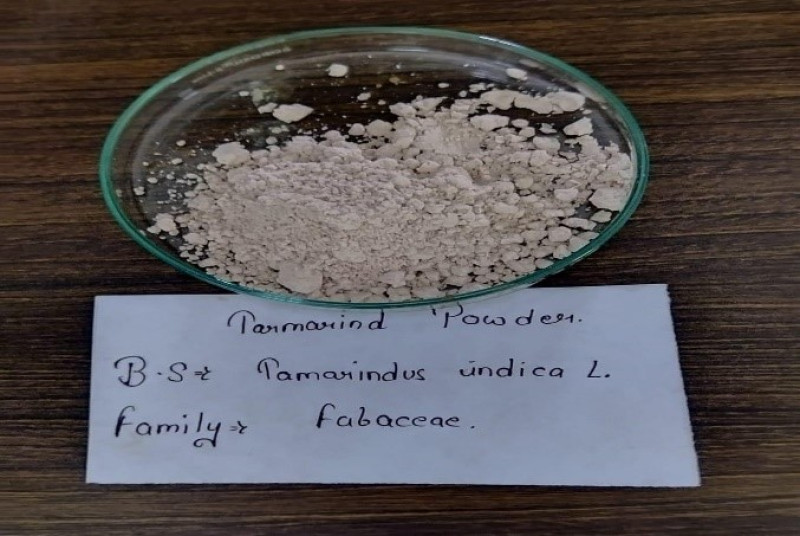
Fig.7: Tamarind
- Neem
Synonym –
Margosa, neem, nimtree or Indian lilac, is a tree
Biological source –
Neem consists of the fresh or dried leaves and seed oil of Azadirachta indica
J. Juss (Melia Indica or M. azadirachta Linn.). belonging to family Meliaceae.
Description –
Colour- Vibrant green ,
Odour- garlic/sulfur
Taste- Extremely bitter.
Chief Chemical constituents –
Oleic acid (50-60%), palmitic acid (13-15%), stearic acid (14-19%), linoleic acid (8-16%) and arachidic acid (1-3%).
Uses –
Neem has antiseptic qualities that can benefit the face.
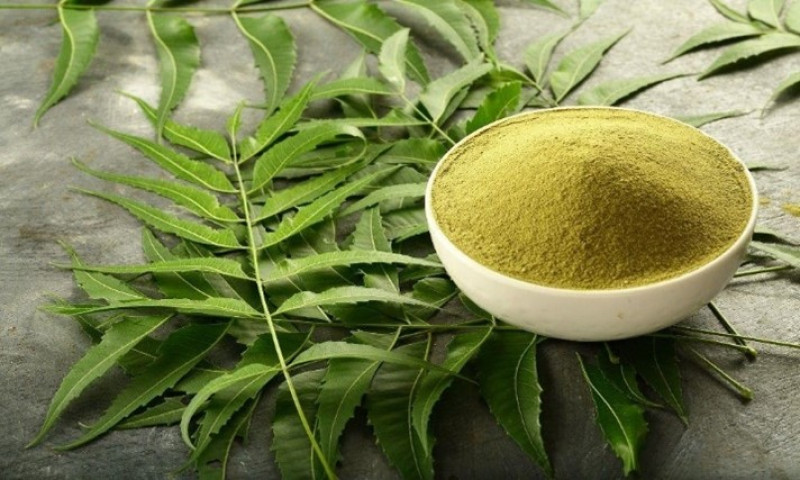
Fig 8: Neem
- Rose
Description –
Colour- shade of red.
Chief Chemical constituents –
Flavonoids, triterpenes, tannins, phenolic acids, polysaccharides, fatty acids, organic acids, carotenoids and vitamins.
Uses –
It help regenerate skin tissues and delay the signs of aging. The antioxidants neutralize free radicals that quicken the appearance of wrinkles, fine lines, and freckles.
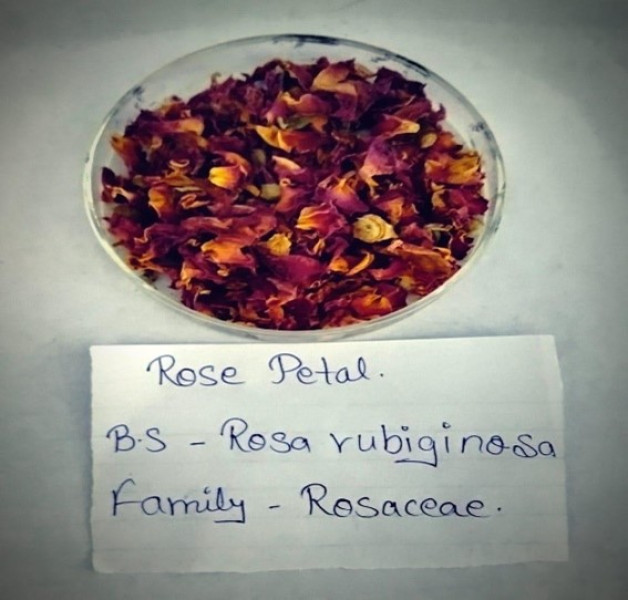
Fig.9: Rose petal
- Multani Mitti
Synonym-
Multan clay
Biological source
It consists of hydrous aluminum silicates (clay minerals)
Description –
Colour- White Odour - Pleasant
Taste – Pleasant
Chief chemical constituents
Montmorillonite, Kaolinite, Attapulgite
Uses-
Nourishes skin, reduce oiliness, Remove blackheads.
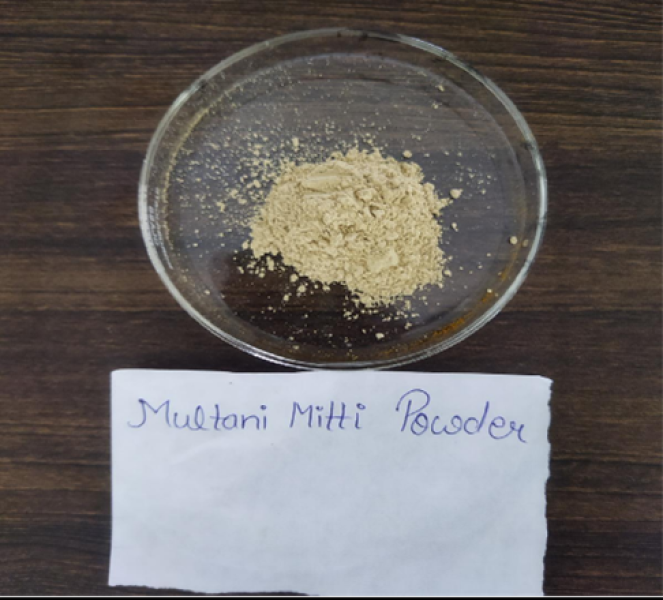
Fig.10: Multani mitti.
Chemicals
Carbopol 940, Methyl paraben, Triethanolamine, Propylene Glycol, Rose Water and Sodium Lauryl Sulphate was collected from the chemical store room of Lucknow Model College of Pharmacy, Lucknow.
METHOD
Preparation of gel-
Methyl paraben was weighed and dissolved in a beaker containing water. Carbapol 940 was added and stirred constantly for few minutes it forms a gel. Sodium Lauryl Sulphate was weighed dissolved separately with water and was added into the above gel. Then the propylene glycol was added. The, tamarind powder, sandalwood powder and the multani mitti was triturated well into the mortar and pestle. Then the prepared gel was added into the active ingredient mixture and stirred. At the end, triethanolamine was added to adjust the pH.
Preparation of exfoliant-
The tamarind peel powder was used as exfoliant. The tamarind peel was taken into the mortar and triturate by using pestle.
PREPARATION OF PLANT MATERIAL EXTRACT
Preparation of Tulsi extraction-
- Firstly, we collected Tulsi from local market.
- Then dried them in Sun light.
- After that, dissolve in a water.
- Then cover it well with aluminum foil and keep it for 3 to 4 days
- After that it will be heated in a water bath at 80 degree until the extract comes out .
- At last filter extract with the help of filter paper.
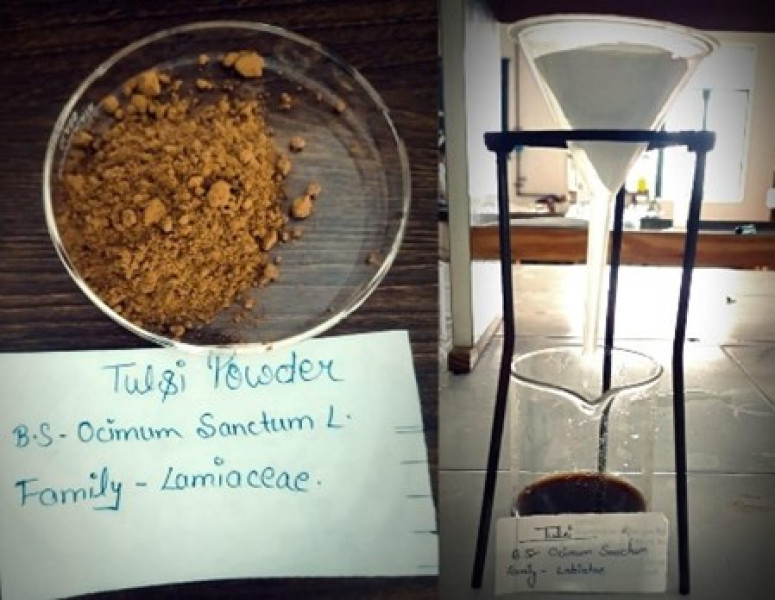
Fig 11: Extraction Process of Tulsi
Preparation of turmeric powder extraction-
- Firstly, we collected turmeric from local market.
- Then dried them in Sun light.
- After that, dissolve in a water.
- Then cover it well with aluminum foil and keep it for 3 to 4 days
- After that it will be heated in a water bath at 80 degree until the extract comes out .
- At last filter extract with the help of filter paper.
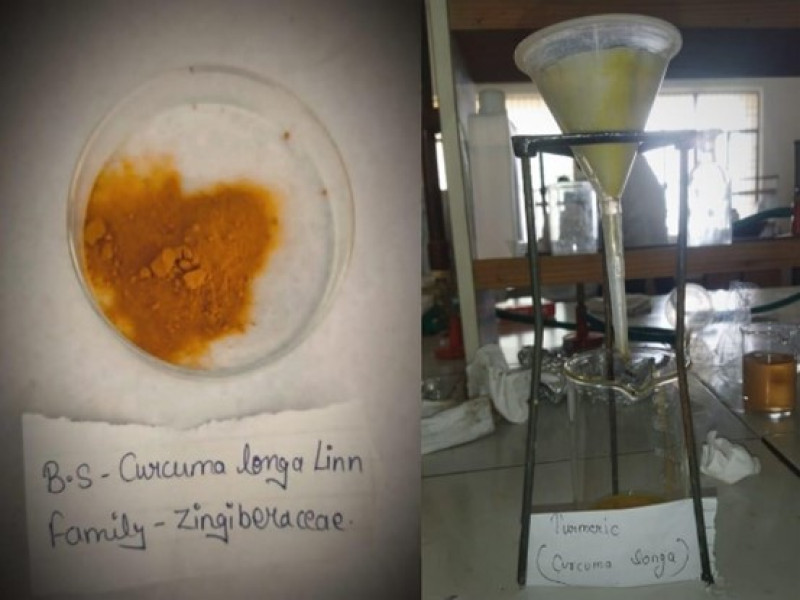
Fig 12: Extraction Process of Turmeric Powder
Preparation of turmeric powder extraction-
- Firstly, we collected turmeric from local market.
- Then dried them in Sun light.
- After that, dissolve in a water.
- Then cover it well with aluminum foil and keep it for 3 to 4 days
- After that it will be heated in a water bath at 80 degree until the extract comes out .
- At last filter extract with the help of filter paper.
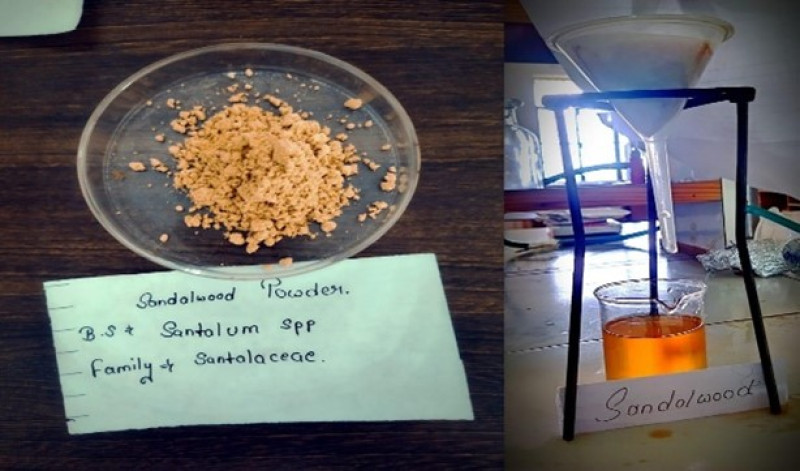
Fig,13: Preparation of sandal-wood powder extraction
FORMULATION OF HERBAL FACE SCRUB
The aim of formulating a Herbal face scrub was found to successful with good results. The face scrub showed a good spreadability. The formulation showed a good peel off property on our skin without causing skin irritation or edema. The present study was attempted to make an herbal scrub using suitable base to form a gel. The prepared scrub was compared with various parameters like colour, odour, consistency, pH, spread ability, extrudability, irritability, wash ability, grittiness, foamability and found to be satisfied with all required characterization. Thus, the developed formulation can be used as an effective scrub for using it to bear a healthy and glowing skin. In this all-natural ingredient were used, so that they had no side effects or fewer side effects. The prepared herbal scrub was found to be satisfied for the application on the skin to make it healthy and glowing. The application of the scrub gel which helps to improve blood circulation and increases oxygensupply to all surface of the skin. After application of scrub, skin becomes softer, cleaner and refreshed.
This project is supported by Lucknow Model College of Pharmacy, Lucknow.
The author would like to thank Dr. Amit Singh (Vice- Chairmen, Lucknow Model group of colleges) and all their mentors. The notes compiled here are collected over a period of time and may have been reproduced verbatim. Apologize to all researchers if in-advertently failed to acknowledge them in the references.


 Kartikay Prakash * 3
Kartikay Prakash * 3
 Polly Gupta 2
Polly Gupta 2













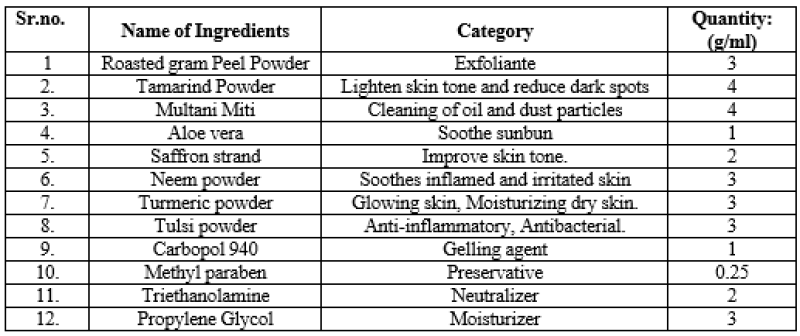

 10.5281/zenodo.10953561
10.5281/zenodo.10953561